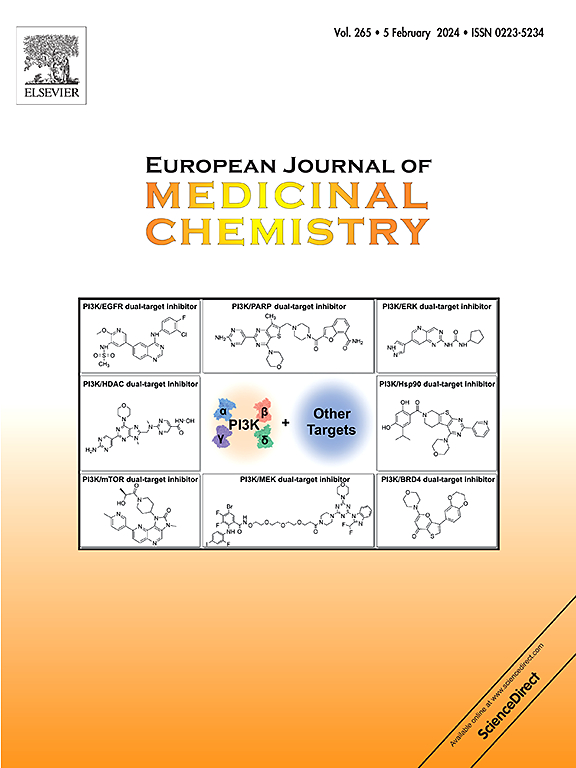Discovery of novel 1,2,3-triazole arylamide derivatives bearing dithiocarbamate moiety as dual inhibitors of tubulin and LSD1 with potent anticancer activity
IF 6
2区 医学
Q1 CHEMISTRY, MEDICINAL
引用次数: 0
Abstract
Targeted inhibition of tubulin polymerization or histone lysine-specific demethylase 1 (LSD1) is considered as a promising therapeutic strategy for cancer treatment. In this work, we reported the discovery of novel 1,2,3-triazole arylamide derivatives bearing dithiocarbamate moiety as dual tubulin polymerization and LSD1 inhibitors through the pharmacophore hybridization strategy, which were derived from the natural product Erianin, and evaluated their anticancer activity through in vitro assays. Among them, compound L-6 was identified as a potent dual tubulin polymerization and LSD1 inhibitor with effective anticancer potency, which demonstrated broad-spectrum antiproliferative activity in vitro with IC50 values below 100 nM against 13 cancer cell lines. Notably, it displayed remarkable inhibitory potency on MGC-803 (IC50 = 33 nM) and HGC-27 (IC50 = 49 nM) gastric cancer cells, which surpassed those of Erianin and the LSD1 inhibitor ORY-1001. Mechanism explorations demonstrated that compound L-6 inhibited tubulin polymerization by targeting the colchicine binding site, thereby disrupting the microtubule network in gastric cancer cells. Additionally, it increased the methylation levels of H3K4me1/2 and H3K9me2/3 in a concentration-dependent manner, thus achieving epigenetic regulation. This dual mechanism involving microtubule depolymerization and epigenetic modulation enabled compound L-6 to effectively suppress colony formation, induce G2/M phase arrest, and promote apoptosis in gastric cancer cells, as well as regulate the expression levels of cell cycle and apoptosis-related proteins. These findings suggested that compound L-6, as a novel dual-target inhibitor of tubulin and LSD1, exhibited potential for the treatment of gastric cancer.


含有二硫代氨基甲酸酯部分的新型1,2,3-三唑芳基酰胺衍生物作为微管蛋白和LSD1的双重抑制剂,具有有效的抗癌活性
靶向抑制微管蛋白聚合或组蛋白赖氨酸特异性去甲基酶1 (LSD1)被认为是一种很有前途的癌症治疗策略。本文报道了从天然产物Erianin中分离到具有二硫代氨基甲酸酯片段的新型1,2,3-三唑芳酰胺衍生物,通过药效团杂交策略作为双微管蛋白聚合和LSD1抑制剂,并通过体外实验评价了它们的抗癌活性。其中,化合物L-6是一种有效的双微管蛋白聚合和LSD1抑制剂,具有有效的抗癌作用,在体外对13种癌细胞表现出广谱的抗增殖活性,IC50值低于100 nM。值得注意的是,它对MGC-803 (IC50 = 33 nM)和HGC-27 (IC50 = 49 nM)胃癌细胞的抑制作用明显优于Erianin和LSD1抑制剂ry -1001。机制探索表明,化合物L-6通过靶向秋水仙碱结合位点抑制微管蛋白聚合,从而破坏胃癌细胞的微管网络。此外,它以浓度依赖的方式增加了H3K4me1/2和H3K9me2/3的甲基化水平,从而实现表观遗传调控。这种涉及微管解聚和表观遗传调控的双重机制使化合物L-6能够有效抑制胃癌细胞集落形成,诱导G2/M期阻滞,促进细胞凋亡,并调节细胞周期和凋亡相关蛋白的表达水平。这些结果表明,化合物L-6作为微管蛋白和LSD1的新型双靶点抑制剂,具有治疗胃癌的潜力。
本文章由计算机程序翻译,如有差异,请以英文原文为准。
求助全文
约1分钟内获得全文
求助全文
来源期刊
CiteScore
11.70
自引率
9.00%
发文量
863
审稿时长
29 days
期刊介绍:
The European Journal of Medicinal Chemistry is a global journal that publishes studies on all aspects of medicinal chemistry. It provides a medium for publication of original papers and also welcomes critical review papers.
A typical paper would report on the organic synthesis, characterization and pharmacological evaluation of compounds. Other topics of interest are drug design, QSAR, molecular modeling, drug-receptor interactions, molecular aspects of drug metabolism, prodrug synthesis and drug targeting. The journal expects manuscripts to present the rational for a study, provide insight into the design of compounds or understanding of mechanism, or clarify the targets.

 求助内容:
求助内容: 应助结果提醒方式:
应助结果提醒方式:


